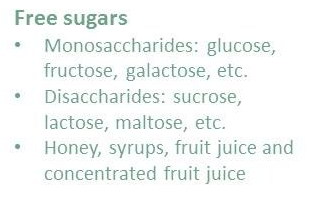
Bad news for those people who love sweet food. In the Guideline: sugars intake for adults and children (2015), WHO recommends a reduced intake of free sugars to below 5% of total energy intake. A few 6 teaspoons of coffee/day (25 g), including sugar that provide food. And this also aims to for those who are thinking: “what are you telling me? I add honey”. Ok, but although it is very “natural”, the bitter reality is that more 80% of honey are also sugars.
The recommendation is further supported by evidence showing higher rates of dental caries when the intake of free sugars is above 10 % of total energy. This evidence shows those adults that increasing the amount of sugars in the diet is associated with a comparable weight increase. In addition, children who consume much more sugar are more likely to be overweight or obese than children with a low intake of sugar-sweetened.
United Kingdom announced that they were going to apply taxes to sugars sweetened beverages, which is an important topic of argument in Europe. In fact, Catalonia has taken the initiative, announcing it expected to establish the first regional assessment to sugars sweetened beverages during the next year. The rate will vary from them 8 cts/L, for drinks that contain 5 to 8 grams by 100 ml, and of 12 cts/L for which overcome it.
It is suggested that priority is given to food categories that commonly represent major sources of added sugars in Member States’ diets, that have a high public health impact or that are recommended to be consumed. According to these criteria, the relevant food categories where efforts should be focused on are:

In CARTIF, we know that reducing content of sugars in food is not easy because aside from sweetness, sugars also influence many product properties.
In bakery products, the role of sugar (sucrose) is very important because also influence many product properties such as the volume, texture and colour:

• Sugar increases gelatinization temperature of starch, so that air bubbles trapped lightening the texture.
• It is a humectant (fixed water), this is important for conservation food e also affect its texture.
• It works as a base for the fermentation of the yeast (for example when the bread is growing).
• Sugar reduces freezing point, what is important to produce softer ice cream and to increase boiling point, fundamental for manufacturing of sweet.
• Sugars are responsible of brown color development of many cooked food, through two processes: Maillard reaction and caramelization.
• Sugars are important for the preservation of the food. High levels of sugar limit microbial growth and allow the food to last longer.
Now, we can already get an idea that reducing sugars is difficult from technological point of view and because changing its organoleptic characteristics. I will leave for a second part of this post how currently the products without sugars are developing.
To finish, a nostalgic video; the first commercial we watched in Spanish television about the gum TREX without sugar (1998), moment in which in less than 30 seconds and to rhythm of the song I´ve been loving youuu, the gum leave of be “a sweet for children”…
- Waiter! One of dung beetles! - 10 February 2023
- Attention: NutriScore Traffic Light! We have a huge mess - 14 January 2021
- Acrylamide has a special ‘COLOR’ - 23 January 2019
